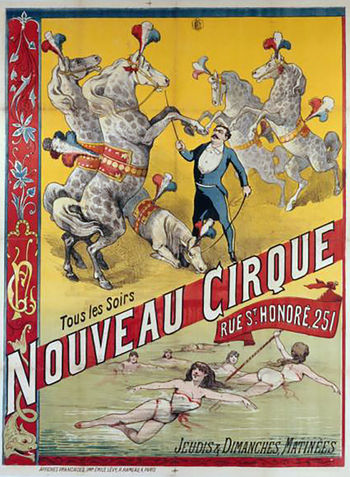Main Page
From Circopedia
|
In The Spotlight
THE NOUVEAU CIRQUE
Located from 1886 to 1926 on the rue Saint Honoré in Paris, a chic shopping thoroughfare at a stone’s throw from the Place Vendôme, the Nouveau Cirque was the most elegant and innovative circus of the French capital—and, for that matter, of Europe. For many years, it was the High Society’s circus of choice. Its relatively small size gave it warmth and intimacy (it was sometimes referred to as a "bonbonniere"), but in time, the Nouveau Cirque’s limited capacity made it difficult to manage. It began to lose its prominence before the first World War and proved unable to adapt to the post-war era.
The Nouveau Cirque was built for its times—what is remembered today as the Parisian "Belle Époque" ("Beautiful Era"), of which it was one of the jewels. After WWI, Paris entered the Jazz Age. Then, in the early 1920s, the venerable Cirque d’Hiver, completely refurbished, returned to the presentation of circus shows after a rather futile hiatus as a movie-house and theater; the Cirque Medrano began to enjoy one of its more lucrative periods; and the brand-new Empire Music-Hall Cirque opened its doors Avenue de Wagram: The small "bonbonniere" that was the Nouveau Cirque looked suddenly like a remnant of another era. It faced a competition it was ill-equipped to fight. Once a revolutionary and trendsetting house whose rich and often glorious life had lasted forty years, the Nouveau Cirque finally called it quits.
The Nouveau Cirque was created by Joseph Oller (1839-1922), an imaginative entrepreneur and prolific provider of Parisian amusements. He was born Josep Oller i Roca in Terrassa, in Spanish Catalonia, on February 10, 1839; his parents were Francesc Oller, a fabric(See: Tissu) merchant, and his wife, Teresa, née Roca. The family emigrated to France when Josep was two years old, and the Ollers settled in Paris where Josep, now Joseph, was raised. He eventually returned to Spain to study at the University of Bilbao in the Basque Country, and while there, he discovered cockfighting, which was still very popular in the nineteenth century. His passion for this gory game led him to become a bookmaker—his first entrepreneurial endeavor.
Back to Paris, Oller transferred his bookmaking activities to horse racing. France had gained by then a new Emperor, Napoléon III, whose half-brother, the Duc de Morny, had been influential in the development of horse racing in France and had built the Deauville-La Touques racetrack in 1862. Morny died in 1865, but with his help, Oller had begun to develop the concept of the "pari mutuel" (literally meaning "mutual betting"), an innovative system in which bets are placed in a pool, and the winners share the losers' stakes—after the bookmaker has taken his commission. Oller put his new system to work in 1867; it replaced advantageously fixed-odds betting and made him a rich man indeed. Oller also launched Le Bulletin des Courses, France’s first horse-racing journal.... (more...)
New Essays and Biographies
- Totti Alexis, Clown
- Ross Mollison, Circus Producer
- Don Saunders, Clown
- Jo-Ann Jennier, Aerialist, Animal Trainer
- Ethel Jennier, Aerialist, Animal Trainer
New Videos
- Promotional Teaser for the Big Apple Circus/Circus-Theater Roncalli (2023)
- Vladimir Serov & Elizabeta Demidova, Aerial Perch (2023)
- Totti & Charlie Alexis, musical clowns (2019)
- The Collins Brothers, comedy trapeze act (1993)
- Peter Shub, clown (2015)
New Oral Histories
- For A Moment You Fly, The First Season of The Big Apple Circus (1977)
- Vladimir Durov Documentary on Russian Television (c.2000)
- Dolly Jacobs Interview at The Ringling (2018)
- Pinito del Oro's Interview on Spanish Television (1970)
- Gia Eradze's Interview on SSU TV (2015)
Circopedia Books
- Philip Astley & The Horsemen who invented the Circus, by Dominique Jando (2018)
A Message from the Founder
CIRCOPEDIA is a constantly evolving and expanding archive of the international circus. New videos, biographies, essays, and documents are added to the site on a weekly—and sometimes daily—basis. Keep visiting us: even if today you don't find what you're looking for, it may well be here tomorrow! And if you are a serious circus scholar and spot a factual or historical inaccuracy, do not hesitate to contact us: we will definitely consider your remarks and suggestions.
- Dominique Jando
- Founder and Curator
